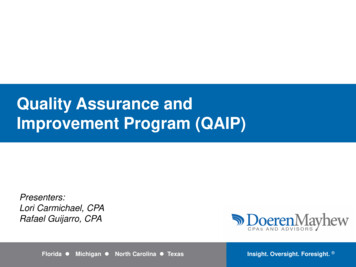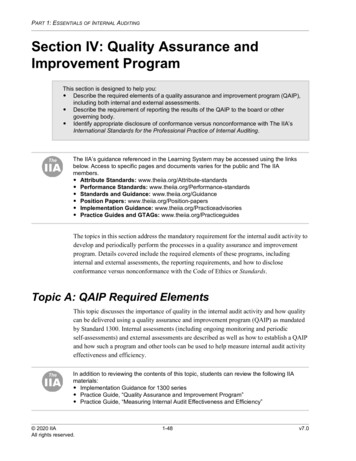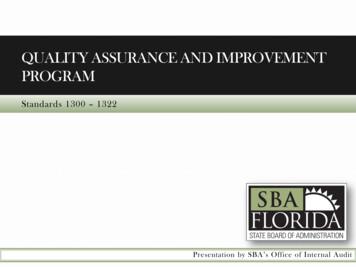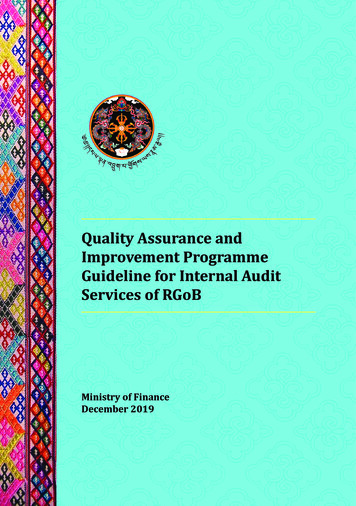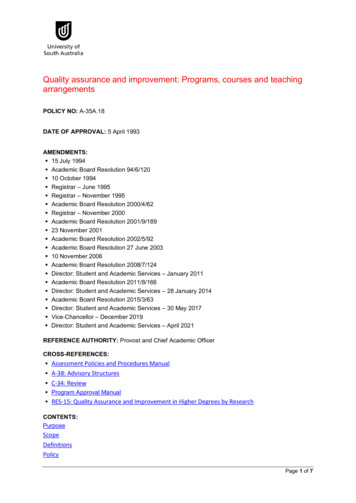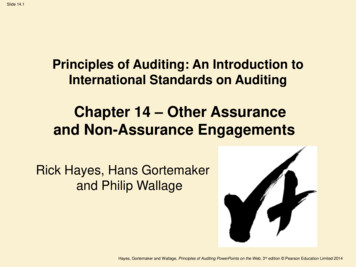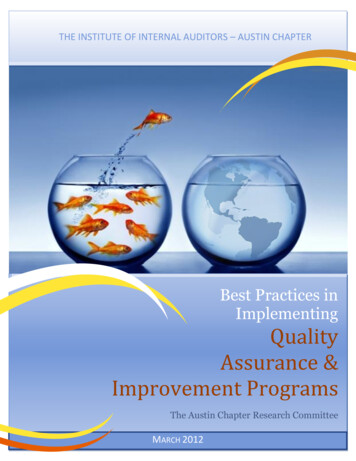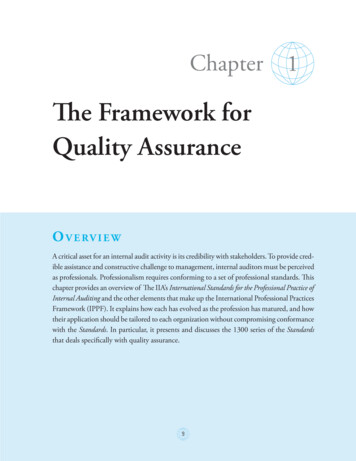
Transcription
Quality Assurance / Quality Improvement ProgramOriginal: July 1997Revised: July 2007Revised: January 2008Revised: October 2009Revised: September 2010Revised: October 2012Revised: March 2014Revised: March 2016
1517 W. Braden Court Orange, CA 92688www.careambulance.net(714) 288-3800March 31, 2016The Care Ambulance Quality Assurance / Quality Improvement Programprovides a system which gathers patient care data, analyzes and reviews thatdata, provides educational and operational feedback to medical personnel, andcontinually audits our performance to assure quality patient care.Clinical Standards are consistent with current medical practice and have beenreviewed for clinical appropriateness and compliance with all federal, state, andlocal requirements.The clinical CQI Program has been carefully considered and approved by theCEO and by the Medical Director of Care Ambulance Service.Troy HagenCEOMichael L. Martin, M.D.Medical Director
Table of Contents4 / Mission Statement5 /Philosophy of Care Ambulance5 / Responsibilities for Oversight5 / QA/QI Interface with Local EMS Agency and State EMS Authority6 / Performance Improvement Organization Chart6 / Description of Processes Used in Conducting QI7 / Prospective Evaluation7 / Recruitment8 / Screening8 / Pre-Employment and Post-Offer Testing8 / Affirmative Action Plan9 / Internal Education/Training Programs9 / New Employee Orientation9 / Field Training Officer9 / Continuing Medical Education11 / Individualized Training11 / OSHA Required Training11 / Required County Training12 / Community Education/Training12 / Criteria Development12 / Scope of Practice12 / Concurrent Evaluation13 / Field Observation13 / Inventory/Equipment Audits2
Table of Contents - continued13 / Child/Elder Abuse Reporting14 /Risk Management14 / Infection Control14 / Safety Standards14 / Employee Injury Reports14 / Hazardous Materials Training14 / Medical Hazardous Waste Handling15 / Retrospective Evaluation15 / Current Indicators16 / Chart Audits17 / Base Station Tape Reviews17 / Facility/Agency Visits17 / Customer Complaint Follow Up17 / Documentation of QI Interventions17 / Incident Reports18 / Target Corrective Measures By Employees18 / Exceptional Performance18 / Specialty Care Review of Sentential Events18 / Advance Life Support of Sentential Events18 / Basic Life Support of Sentential Events19 / Quality Review Committee20 / Quality Improvement Program Goals and Objectives20 / Technical Advisory Group (TAG)21 / Program Review23 / Attachments3
Mission StatementThe continual process of assessing and monitoring individual and systemperformance, as well as documenting that performance, is the responsibility ofquality assurance and quality improvement. Care Ambulance’s Quality Assuranceand Quality Improvement Program is predicated on the belief that field personnelare highly skilled medical professionals empowered to make judgments that if notproperly executed could have far reaching and serious consequences for patients.It is the goal of Care Ambulance to adopt the standards of patient care andprotocols established by the State of California and local EMS agencies as theminimum standard by which we measure our performance. The Care AmbulanceQuality Assurance and Quality Improvement Program provides a system whichgathers patient care data, analyzes and reviews the data, provides educational andoperational feedback to medical personnel and continually audits our performanceto assure quality patient care.4
PHILOSOPHY OF CARE AMBULANCECare Ambulance commits itself to quality patient care and that commitment is evident in the quality ofcare provided to each and every patient.RESPONSIBILITIES FOR OVERSIGHTThe QA/QI Manager shall be the management representative responsible for the day-to-day monitoringof the QA/QI process. The Paramedic Coordinator will be the primary person responsible for oversightof the EMT-P component of the Quality Program for Advanced Life Support. The Specialty Care NurseManager will be primary person responsible for oversight of the Specialty Care Transposition QualityProgram. The Operations Director will have the responsibility for the overall direction of the QA/QIprogram. The Medical Director will have significant input and control of the program.QA/QI INTERFACE WITH LOCAL EMS ANGENCY AND STATE EMS AUTHORITYThe QA/QI Manager and Paramedic Coordinator will be responsible for the direct interaction withthe local EMS Agency, and will be an active participant in any county EMS/QI process.By cooperating with the local EMS agencies (LEMSA) in the implantation, monitoring, datacollections and evaluation of EMS required indicators, Care Ambulance Service integrates our QA\QI program with the California EMS Authority.As an approved Advanced Life Support Provider in Los Angeles County it is a requirement toparticipate in the TEMIS Data Entry Program.The QA/QI Manager will provide direct oversight of the TEMIS Data entry process. The QA/QIManager and all personnel who will be performing data entry on the TEMIS system will be requiredto attend a minimum of 16 hours of TEMIS basic software training and 24 hours of advanced /refresher training per year.5
QA/QI interface with local ems agency and state ems authority - cont.QA/QI Manager or his/her designee will be responsible for ensuring that the following are reported to theEMS Agency: Clinical ConcernsTEMIS DataAdverse TrendsSpecial Topic AuditsOther specific items requested by the agencyPerformance Improvement Organizational ChartThe QI program/process demonstrates the dissemination of QI information to all participants, (i.e.,administration, EMT’s, dispatchers, paramedics, base hospitals and other provider agencies.)See attachment 1ADESCRIPTION OF PROCESSES USED IN CONDUCTING QIThe continuous QI Process used by Care Ambulance Service is:PDCA.P - Plan, Analysis, Conclusions, Recommendations Description of current process or outcome Analysis of findings Conclusions based on findings Recommendations to improve performanceD – Do/Act What action did you take to improve the performance When did you take the action(s) to improve performanceC – Check How effective were the actions to improve performance Briefly describe the performance improvement Did the action have an impact on patient care Did the action have an impact on customer satisfaction Did the action have a financial impact Will there be a long-term benefitA – Act When will the action be monitored to determine the effectiveness How long will the action be monitored to ensure improvement and/or resolution How often will the effectiveness of the action be monitored6
PROSPECTIVE EVALUATIONThe Prospective element is a key component to theQA/QI process. Strong emphasis on prospectivewill increase the probability of positive findings inconcurrent and retrospective evaluation.The following are key areas of prospective evaluation: Recruitment Screening Pre-Employment and Post-Offer Testing Affirmative Action Plan Internal Education/Training Programa. New employee orientationb. Field training officer/preceptor programc. Continuing medical educationd. Individualized traininge. OSHA required trainingf. Required county training Community Education/Traininga. Ambulance demonstrationsb. Safety and prevention programsc. EMT-1 Career Day presentationsd. CPR, First Aid, and AEDe. Specialty presentations on EMS related topicsRECRUITMENTThe Care Ambulance recruitment philosophy is to select top quality EMT candidates based on current and projectedneeds. Selection of the most qualified EMT candidates is accomplished through the following mechanisms: Referrals from current and former employees.Referrals from EMT Training Instructors.Solicitation through newspaper classifieds, trade journals, and agreements with approved traininginstitutions.Participation in career day events, and presentations to EMT classes.Open HouseCare Ambulance believes that career opportunities should be available for all employees. Employees areviewed as internal clients. The organization has the same long-term commitment for external customers andinternal clients.77
SCREENINGTo ensure that the most qualified applicants are selected for employment requires appropriate screening.The following mechanisms are used for the screening process: Review of application with focus on ability to follow instructions and experience. Written job descriptions containing prerequisite job requirements. Structured oral interview with two managers. Background investigation to verify information on application. Review of motor vehicle driving record.At the completion of the screening process only the most qualified candidates are selected to participate inthe pre-employment and post-offer testing.PRE-EMPLOYMENT AND POST-OFFER TESTING Complete D.O.T. PhysicalUrinalysis Drug ScreeningMedical History and ExaminationT.B. Skin TestingStrength and flexibility testing completed by licensed physical therapistCybex back and knee testing.Individuals, who successfully complete all required pre-employment and post-offer testing, will thenbecome a key component in the delivery of Quality Patient Care.AFFIRMATIVE ACTION PLANCare Ambulance Service, Inc. is an equal opportunity employer. Care Ambulance Service does notdiscriminate in employment on the basis of race, color, religion, gender, national origin, age, disability,Vietnam Era veteran or special disabled veteran status, sexual orientation or any other protected status asprovided by law.While not required by law, all candidates receive an Affirmative Action Survey during the hiring process.The information is collected and reviewed to insure that Care Ambulance Service meets all of theDepartment of Labor’s Employment Standards.8
INTERNAL EDUCATION/TRAINING PROGRAMSEducation and training are extremely important aspects of the quality process. All employees areencouraged to further their education both through internal and external sources. The following is a list ofsome of the areas of internal training:New Employee OrientationAll new employees will attend an orientation class. The class will prepare the employee to represent thecompany in a positive manner, and function well in the Local EMS system. Below is a list of the topicscovered in this orientation. Company policy and proceduresOverview of the organizational structureCommunicationsSafe vehicle operationQuality ImprovementResources availableOverview of the Local EMS AgencyHospital and specialty care facility locationsOperations overviewField Training Officer (F.T.O.s)F.T.O.s are individuals who have been designated as training representatives. He/she may be utilized toprovide field internship to an EMT student, field and classroom training of assigned personnel, or workwith a currently certified individual who requires some refresher training.The selection of individuals to be F.T.O.s will require the approval of the Training, Operations, andQuality Improvement Departments. An F.T.O. is expected to lead by example in the performance of his/her daily duties. Any significant disciplinary or quality care problems may result in the individual losingtheir F.T.O. status.Continuing Medical EducationContinuing education will be provided for all field employees. Care Ambulance recognizes theimportance of basic life support and critical care transports. Classes with curriculum to meet the specificneeds of the EMT-1 are offered.Training topics are based on employee and system needs. Trends that are identified will also be referred tothe Training Department for curriculum development.99
The Local EMS Agency may identify specific areas that require training. Care Ambulance, as a state andcounty approved provider, will fully comply with all requirements.Some of the continuing education classes that may be offered are: CPR and AED RecertificationCPR and AED Instructor CoursePatient AssessmentDocumentationHow to Assist the ParamedicEMT SkillsVarious Medical TopicsVarious Trauma TopicsPediatric CareInfection Control / Hazardous MaterialsField Care AuditsChild/Elder AbuseContinuing education is crucial to ensuring ongoing quality. An increase in knowledge and confidenceleads to an increase in the quality and level of care provided.1010
Individualized TrainingIndividualized training may take the form of refresher training and/or evaluation based on a concernraised by the individual, supervisors or others. The Training and Quality Improvement Departmentswill work in conjunction to develop an action plan to ensure that every opportunity for success isgiven to the individual.The action plan will be specific to meet the identified needs. After successful completion theindividual will be monitored for continued compliance. The individual’s supervisor will be apprisedof the progress and results of the action plan, with recommendations for continued progress. TheTraining and Quality Improvement Departments will make recommendations to the individual’ssupervisor. Under no circumstances will an individual with clinical concerns be allowed to return tothe field until approval from Training and Quality Improvement.All Care Ambulance employees are encouraged to seek additional training in areas they feel arenecessary. An employee may approach a representative from Operations, Training, or QualityImprovement and request information on a specific topic. The employee may be given literatureon the topic and/or referred to an individual that can provide them with the information needed. Ifthe needs of the employee cannot be met internally then they can be referred to an external source toobtain the required information.OSHA Required TrainingCare Ambulance will be in full compliance with all OSHArequirements. Internal resources will provide infection controland blood borne pathogen updates. All records of training willbe maintained as specified by OSHA.Required County TrainingCare Ambulance will work closely with the Lo
quality assurance and quality improvement. Care Ambulance’s Quality Assurance and Quality Improvement Program is predicated on the belief that field personnel are highly skilled medical professionals empowered to make judgments that if not properly executed could have far reaching and serious consequences for patients.


